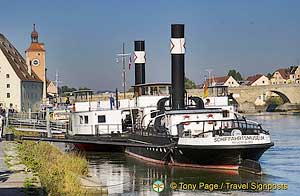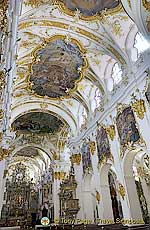Regensburg, Germany – Danube River Cruise:
See our Regensburg Photos HERE
| RIVER CRUISE GUIDE | Bank (Danube) | Right | KM | 2379 |
| Altitude | 336m/1,102ft | Population | 150,000 |
 Regensburg is also called Ratisbon, and is situated at the confluence of the river Regen into the Danube. The present-day old city was a Celtic settlement (Radasbona), which later became the site of a Roman stronghold and legionary camp, Castra Regina (founded 179AD). The Roman north gate (Porta Praetoria) and parts of the walls survive.
Regensburg is also called Ratisbon, and is situated at the confluence of the river Regen into the Danube. The present-day old city was a Celtic settlement (Radasbona), which later became the site of a Roman stronghold and legionary camp, Castra Regina (founded 179AD). The Roman north gate (Porta Praetoria) and parts of the walls survive.
The capital of the dukes of Bavaria from 530AD, it was made a bishopric in 739AD and shortly afterward became a capital of the Carolingians. The only imperial free city in the Duchy of Bavaria from 1245, Regensburg became very prosperous in the 12th-13th C. However, it was taken by the Swedes and later by imperial troops in the Thirty Years’ War (17th C) and was destroyed by the French in 1809, passing to Bavaria in 1810. The astronomer Johannes Kepler died here in 1630, and the painter Albrecht Altdorfer (d. 1538) was both a city architect and councillor.
Regensburg was home to a Messerschmitt Bf 109 aircraft factory and an oil refinery and as such attracted heavy bombing by Allied forces in World War II. Although both of these targets were badly damaged from the repeated bombings, Regensburg itself sustained little damage and most of its medieval buildings survived. Its imposing patricians’ houses (12th-14th C) are unique in Germany; and the Steinerne Brücke (Stone Bridge, 1135-46) across the Danube is a medieval constructional marvel that was repaired after the war.
 The Cathedral of St Peter (1275-1524) is one of the most important Gothic churches in Bavaria, with 14th C stained-glass windows and two Romanesque chapels in the adjoining cloisters. Its Boys’ Choir (Regensburger Domspatzen) is well known. Other notable churches include the Romanesque St Emmeram’s, parts of which date to the 8th C; the Alte Kapelle (Old Chapel), the earliest parts of which date from circa 1000, with an elaborate Rococo interior; the 12th C Romanesque Schottenkirche St Jakob, founded by Irish monks; the 13th C Dominican Church; and the Minorite Church (c. 1250-1350), incorporated into the town museum.
The Cathedral of St Peter (1275-1524) is one of the most important Gothic churches in Bavaria, with 14th C stained-glass windows and two Romanesque chapels in the adjoining cloisters. Its Boys’ Choir (Regensburger Domspatzen) is well known. Other notable churches include the Romanesque St Emmeram’s, parts of which date to the 8th C; the Alte Kapelle (Old Chapel), the earliest parts of which date from circa 1000, with an elaborate Rococo interior; the 12th C Romanesque Schottenkirche St Jakob, founded by Irish monks; the 13th C Dominican Church; and the Minorite Church (c. 1250-1350), incorporated into the town museum.
The buildings of St Emmeram’s Abbey (founded 7th C) have been the palace of the princes of Thurn and Taxis since 1812 and there are remains of the 13th C Herzogshof, the residence of the Bavarian dukes. The town hall (14th-15th C) contains the Reichssaal (c. 1350), in which the Imperial Diet was held from 1663 to 1806.
The city is an important cultural, industrial, and commercial centre, a road and rail junction, and a head of navigation on the Danube with a busy port area. Products manufactured in the area include electronics, steel and motor vehicles, and wood. Regensburg is also a tourist base for excursions into the Bavarian Black Forest (Schwarzewald), and is famed for its sausages! The University of Regensburg was founded in 1962.
See our Regensburg Photos HERE
Don’t know where a place is? Try this map (opens in new window): Map of Germany
Or visit our zoomable Google Satellite Map page
TRAVEL TO GERMANY WITH US: PHOTO HIGHLIGHTS
Other Germany pages:
Travel to Germany: a Europe Tour that’s a lot more than Beer, Lederhosen and
Cuckoo Clocks!
When to travel to Germany for your tour: weather and seasons
Useful facts, dates and links to help you plan your tour of Germany
Book your sightseeing tours or day-trips in Germany online

 Take Better Digital Photos eBook
Take Better Digital Photos eBook Guerrilla Travel Photography eBook
Guerrilla Travel Photography eBook
you have very nice pictures of Regensburg here…I live near this city and I love it…That is the Stone Bridge out there on Danube River..very informative article.